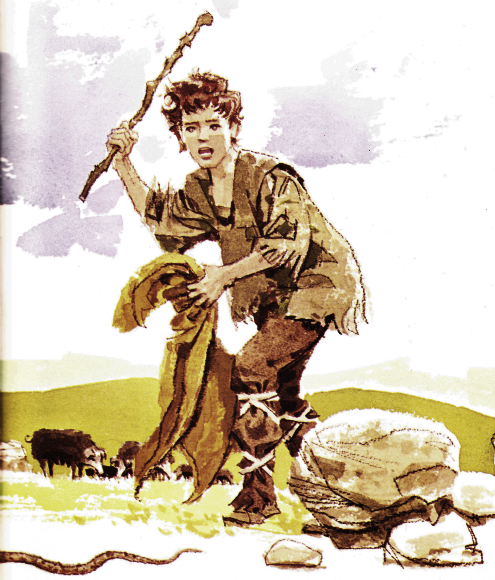The Legend of St. Patrick

The boy with his hands bound behind his back was chained to other slaves on the deck of the pirate ship. He had been in the dark hold so long that now the daylight blinded him. Beyond the shoreline the earth wore the greenest-green he had ever seen. Above it, in the distance, rose the hills and mists and the mountains of the Antrim coast of Ireland.
Along with other slaves he was jerked ashore. As soon as his feet touched land, a powerful chieftain grabbed him.
“What are you called, lad?” he said, shoving him into the cart.
“Patrick Magonus Sucatus,” the boy answered.
“Fetched from …..?”
“Bannavem Taberniae. I was hunting in my father’s wood. The pirates came on me from behind.”
“A Roman, be ye?”
“My father is Calpurnius, a deacon and Roman official. My mother is Conchessa, and French.”
“Be ye Christian?”
“I am.”
“Away with all. Ye be Patrick, the slave, now, the pig tender.”
It was the fifth century. Ireland was wild, pagan country. Many of the Picts in the north were pirates and slave traders. They saw nothing wrong in this work. They were big brave men who wore bright tattoos on their skin. Their pagan religion had no love in it. No thought for another’s misfortune. It was cruel, and held the people by fear.
For seven years Patrick tended pigs on Slemish Mountain. He was often cold and hungry. It was then that he came to love Jesus so much. For Jesus was all he had left from home. And compared to the gods the Irish worshiped, Jesus was a marvel of love. He talked to him through all his loneliness. He spoke to him in the prayers he knew. And he made up new ones for comfort. Now all he wanted was to be free, so that he could become a priest.
There were only two things in this country he hated. And he always saw them together: the deadly snakes that slithered through the moist green fields, and the evil power of the pagan religion over the people.
One night he had a dream. In it he heard a voice saying: “Run away, Patrick. A ship is waiting to take you home!”
The next night Patrick escaped. He ran through the darkness to the Irish coast. There, as the dream promised, a ship was about to sail for France. He had no money, but he promised the captain his parents would pay his passage and he was taken aboard.
Aftre a perilous journey, they arrived at Patrick’s old home. There was much rejoicing. Patrick’s family told him of their great plans for him. But he was restless. He wanted to become a priest. He missed the land of his slavery. He went to France. There, we are told, he lived like a hermit and studied under the great monk-teacher, Martin of Tours. He became a priest, then a bishop. All the while he longed for Ireland.
And then one happy day Patrick was chosen to head a mission back to his land of slavery! It was not easy to change the faith of a nation and it was not easy for Saint Patrick. But gradually he worked through the land. Everywhere there was talk of him.
“The love of him,” the people said. “To leave his own and become one of us.”
“The greatness of him,” they said. “He drummed the snakes out of Ireland into the sea.”
“The pure wisdom of him,” they cried. “With the little shamrock he explains the Trinity.”
“The power of him,” they boasted. “He brings us heaven and ends the sting of death.”
Under Saint Patrick the whole country became Christian. Some say he was seventy-six when he died. Others swear he lived to be one hundred and twenty. Some say he comes back every Easter Eve, and that at midnight, if the wind is right, you can hear him singing hallelujahs in the Irish hills. It is indeed safe to say he will live in Irish hearts forever.
Happy St. Patrick’s day.
![]()








